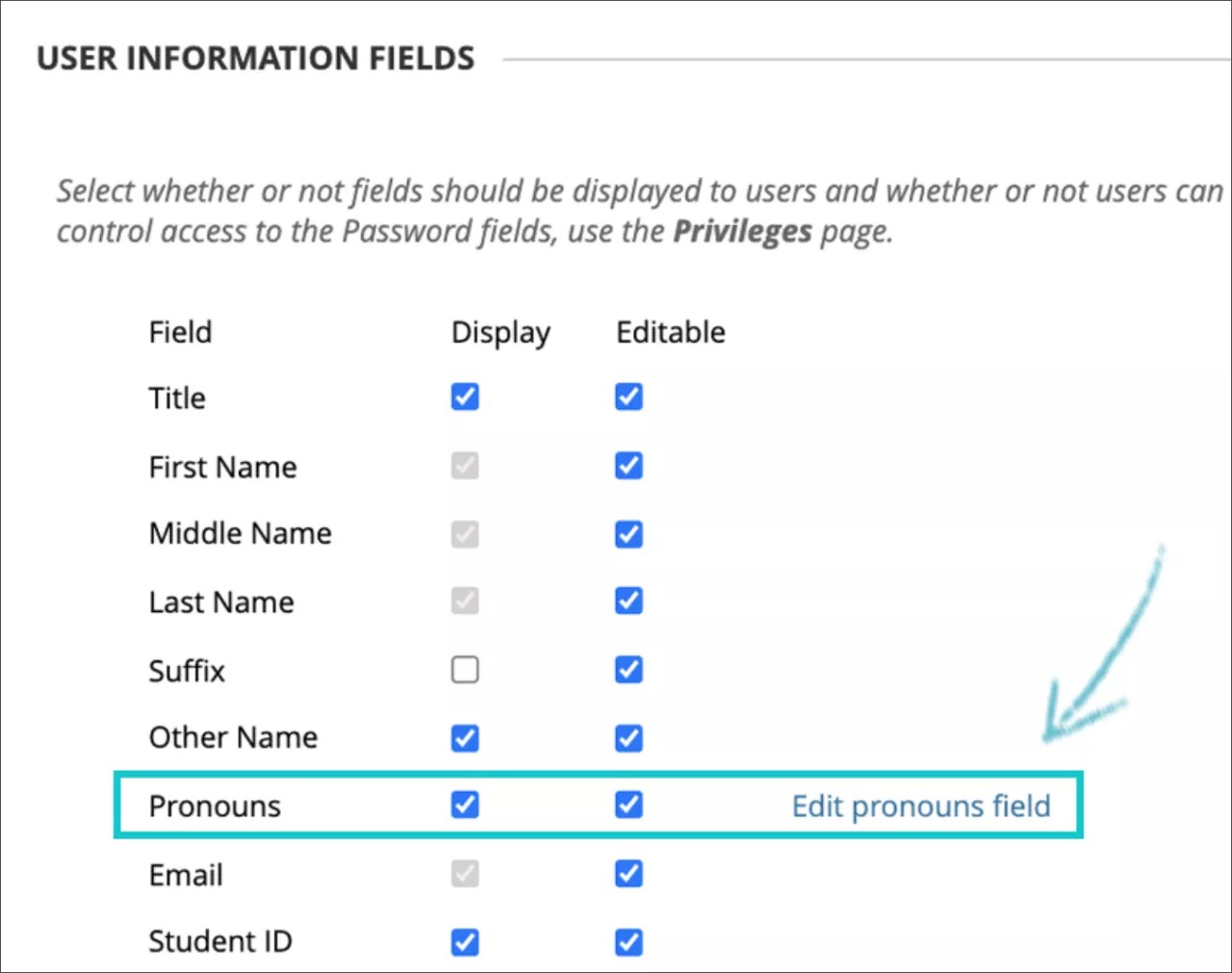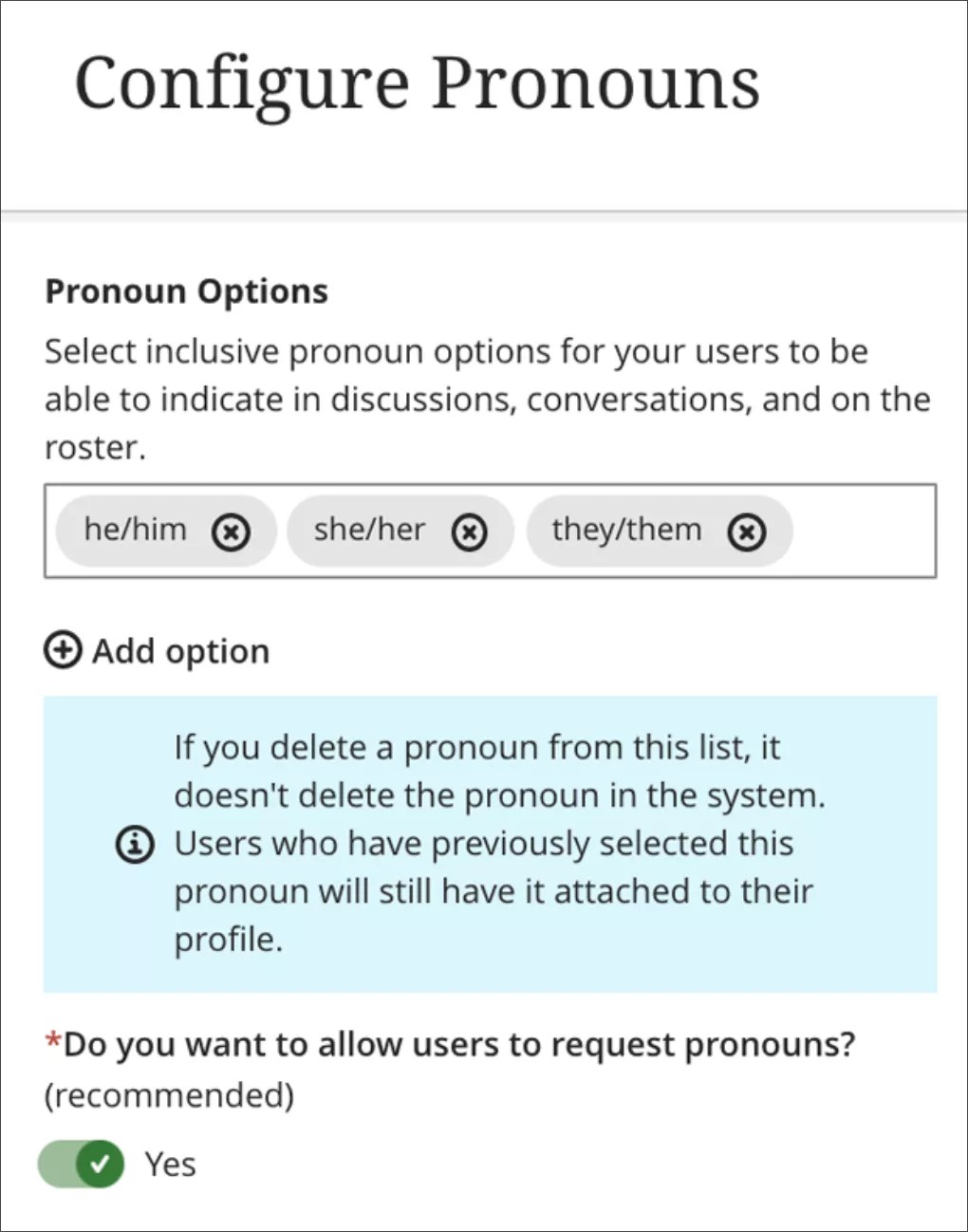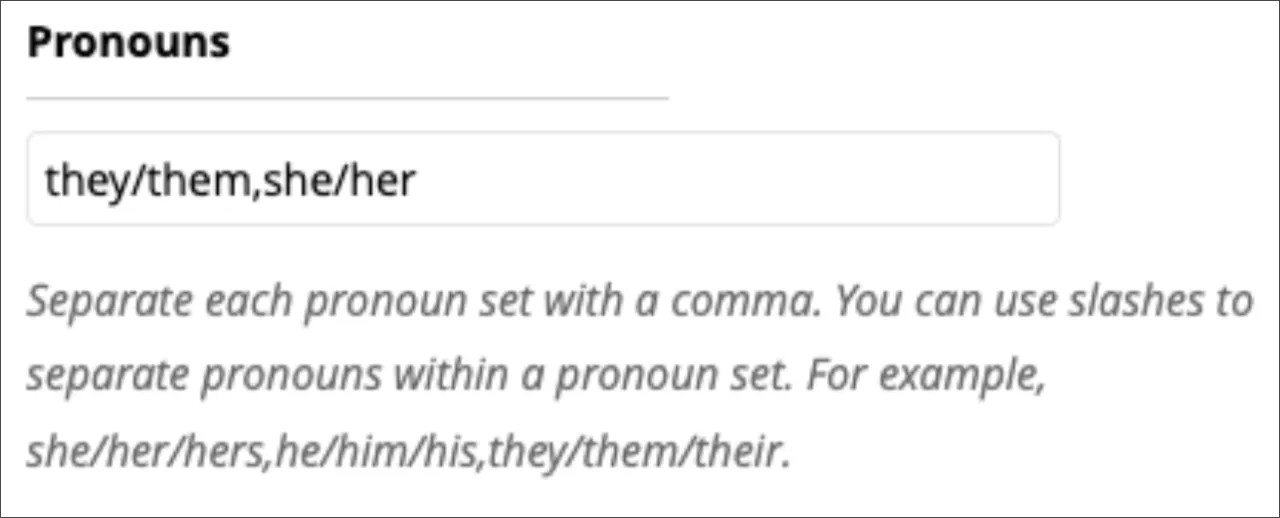Expression of personal pronouns to others
To be considerate and respectful of others, it’s important to understand the pronouns by which others are addressed in languages that have gendered pronouns, such as English. This is particularly meaningful for users who are gender non-binary, have a name that can apply to anyone, or have a name that is less familiar to others. In Learn, pronouns can be set to display to other users with the values set either by individuals themselves or be populated from an external system of record, such as a student information system (SIS).
Configuration of pronouns
The pronoun field is enabled by administrators at institutions where policy, culture, and users’ languages determine the need. This field, like other user information, is managed in Administrator Panel > Customize User Information.
- If you enable the Display option for the pronoun field, your users in courses will see any populated pronoun values for other users.
- If you enable the Editable option for the pronoun field, your users will be able to select and set their own pronoun values on their profile page from the allowed pronoun options. When set to editable, you must configure pronoun options on the Configuration page, in the Edit pronouns field.
On the Configuration page, Edit pronouns field, you can set any pronoun value combinations that best reflect your institution’s policies, culture, and users’ languages. For each pronoun option, select Add option. They can be formatted as desired using any character set, but commas aren’t allowed. Use slashes to separate values in a pronoun set such as she/her or she/her/hers, dependent on institutional policy. If your institution supports programs and users in multiple languages with gendered pronouns, all values can be added to the approved list. Your users will be able to select all the values that apply to them across those languages.
For English, configure at least the she/her, he/him, and they/them pronouns. Some institutions will need additional options or different formatting to conform with culture, policy, and user expectations.
Using an approved list prevents users from adding inappropriate or bullying comments, but it does mean that institutions may need to address missing options, particularly since needs may change over time. You can optionally allow users to request a new pronoun option. When enabled, requests include information about the requestor and are emailed to the address on file for the primary support contact (defined in the Admin Panel > System Configuration > Email Configuration section). You, or the owner of that email, can review these requests and handle them through any necessary approval procedure before you add them to the approved list.
The approved list only constrains what users may select themselves. Removing an approved option only prevents to select it in the future. Options aren’t editable. Data integration would be required to change pronoun forms—for example, changing “she/her/hers” to “she/her.”
When the pronoun field is set to 'Display', users in Original Experience who access their profile page via My Blackboard > Settings > Personal Information, will see pronouns as 'read-only' regardless of the Editability field's configuration. Pronoun selection by users themselves requires Base Navigation to be enabled.
Editions to pronoun values
Support users with administrative rights to edit user personal information, can manually edit users’ pronoun values on the Administrator Panel > Users. The separator between pronoun values is comma. The values set there aren't constrained by the approved options list.
Data integration to populate pronouns
A new Pronouns field for users was added to integration frameworks including REST, SIS flat file, XML, LIS, and IMS Enterprise methods. Since pronouns aren't part of the LIS and IMS Enterprise standard, this field was added to those types as an extension.
A user’s pronoun values are all stored as a single entry on the user record. When multiple pronoun values apply to a user, these should be comma-separated. Use slashes to separate pronouns in a set. For example, the value for a user might be “she/her, they/them”. The approved pronoun options configured in the user interface doesn't constrain the values that can be populated through data integration.
When you use the SIS framework, standard configuration behaviors apply. The field can be set to always be managed by the SIS, set initially when the user is created but then managed in Learn, or always managed in Learn. To set this behavior, edit the SIS integration configuration in Administrator Panel > Data Integration > Student Information System Integrations > (name of configuration) > Advanced Configuration > Users > Field Mapping. Toggle this behavior with the Change on update option. It's not recommend to use a configuration in which Change on update is enabled and the field is also set to editable as this will cause user frustration since the changes they make in Learn are overwritten by the SIS.
Considerations for privacy and use of personal data
Before you implement this feature, review your implementation to ensure compliance with local law and privacy policies. In many jurisdictions, pronouns are considered sensitive personal information. If you allow your users to select and remove their own pronouns in Learn, this will be compliant with many institutions’ policies because users are opting in to share this information with others as part of their profile.
If populating pronoun information from a system of record such as an SIS, privacy policy and use of data should be considered more carefully. When that information was provided previously by that user, did they approve to share it with others in the institution? Is there a way for a user to opt-out in systems of record so the information is removed from their profile in Learn?
If pronoun data exists in the SIS but you need to enable users to opt-out in Learn, if policy allows, you could update all existing user records once with change on update mode enabled. This would populate the pronoun data as it is presently known in the SIS. Set the pronoun field to editable in Learn, then disable change on update in the SIS configuration. With this configuration, if users make changes to their pronouns in Learn or delete them entirely to opt-out, those changes won’t be impacted by later data updates from the SIS.


